Understanding where habaneros fall on the heat spectrum helps cooks and spice enthusiasts make informed decisions about using these vibrant peppers. The Scoville scale, developed by pharmacist Wilbur Scoville in 1912, measures capsaicin concentration—the compound responsible for chili pepper heat. Modern testing uses high-performance liquid chromatography (HPLC) for precise measurements, though the Scoville scale remains the standard reference.
Decoding Habanero Heat Levels
Habaneros aren't just hot—they represent a substantial jump in heat intensity compared to common supermarket peppers. While individual heat can vary based on growing conditions and specific varieties, the standard habanero consistently delivers mouth-tingling heat that builds gradually before reaching its peak.
The wide range (100,000-350,000 SHU) reflects several factors:
- Varietal differences—Red, orange, and chocolate habaneros have distinct heat profiles
- Growing conditions—Soil quality, climate, and water stress affect capsaicin production
- Ripeness—Fully mature peppers generally pack more heat
- Individual pepper variation—Even on the same plant, heat levels can differ significantly
| Pepper Variety | Scoville Heat Units (SHU) | Heat Relative to Jalapeño |
|---|---|---|
| Habanero | 100,000–350,000 | 20–70x hotter |
| Jalapeño | 2,500–8,000 | Baseline |
| Serrano | 10,000–23,000 | 2–9x hotter |
| Cayenne | 30,000–50,000 | 6–10x hotter |
| Ghost Pepper | 855,000–1,041,427 | 170–200x hotter |
Habanero Varieties and Their Heat Differences
Not all habaneros deliver identical heat experiences. Different varieties exhibit distinct Scoville ratings:
- Red Habanero—Typically 300,000–350,000 SHU, considered the hottest common variety
- Orange Habanero—Generally 100,000–200,000 SHU, slightly milder with pronounced citrus notes
- Chocolate Habanero—Ranges 250,000–300,000 SHU, featuring earthy undertones alongside intense heat
- White Habanero—Approximately 150,000–250,000 SHU, known for its floral aroma
Understanding these variations helps explain why some habanero experiences feel dramatically hotter than others, even when using the same pepper type. This knowledge proves valuable when following recipes that specify particular habanero varieties.
Factors Influencing Habanero Heat Intensity
Several environmental factors significantly impact habanero heat levels:
- Water stress—Peppers grown with moderate water stress often develop higher capsaicin concentrations
- Soil composition—Mineral-rich soils can enhance heat production
- Climate conditions—Warmer temperatures generally increase capsaicin levels
- Harvest timing—Fully ripe peppers typically exceed the heat of underripe counterparts
These variables explain why habaneros purchased from different sources might deliver noticeably different heat experiences despite being the same variety. For consistent results in cooking, consider testing a small piece before adding the entire pepper.
Safe Handling Practices for Habaneros
Given their substantial position on the habanero heat scale, proper handling techniques prevent uncomfortable experiences:
- Always wear gloves when cutting or handling habaneros
- Avoid touching your face, especially eyes, during preparation
- Wash hands thoroughly with soap after handling, even when wearing gloves
- Use separate cutting boards for hot peppers to prevent cross-contamination
- Remove seeds and white membranes (placenta) for reduced heat intensity
Understanding habanero scoville rating implications helps prevent accidental over-spicing. If you experience skin irritation, apply milk or yogurt to affected areas—capsaicin dissolves in fats better than water.
Common Misconceptions About Habanero Heat
Several myths persist about habanero heat levels:
- Myth: Color indicates heat level—Reality: While color correlates with variety, it doesn't reliably predict heat within the same variety
- Myth: Smaller peppers are always hotter—Reality: Size has minimal correlation with heat; growing conditions matter more
- Myth: Removing seeds eliminates heat—Reality: While seeds carry some capsaicin, the highest concentration exists in the white membranes
- Myth: Habaneros are the hottest peppers available—Reality: They're significantly milder than ghost peppers, Carolina reapers, and other super-hots
Practical Applications of Habanero Heat Knowledge
Understanding the habanero pepper heat level chart transforms how you use these peppers in cooking. Their distinctive floral, fruity flavor combined with substantial heat makes them ideal for:
- Sauces and hot sauces where flavor complexity matters as much as heat
- Salsas that benefit from tropical fruit pairings (mango, pineapple)
- Caribbean and Yucatecan cuisine where habaneros are traditional ingredients
- Marinades that need both flavor depth and moderate heat penetration
When substituting habaneros in recipes, remember that one habanero often equals 20-30 jalapeños in heat intensity. Start with small amounts and taste carefully before adding more—habanero heat builds gradually but delivers lasting effects.
Frequently Asked Questions
How does habanero heat compare to jalapeño?
Habaneros are significantly hotter than jalapeños, measuring 100,000-350,000 Scoville Heat Units compared to jalapeños' 2,500-8,000 SHU. This means habaneros are typically 20-70 times hotter than jalapeños, explaining why even small amounts of habanero create intense heat experiences.
Why do some habaneros taste hotter than others?
Habanero heat variation stems from multiple factors including growing conditions (soil, climate, water stress), specific variety (red, orange, chocolate), ripeness level, and individual plant genetics. Even peppers from the same plant can show significant heat differences due to these variables.
What's the mildest habanero variety available?
The yellow or orange habanero varieties generally register at the lower end of the habanero heat scale (100,000-200,000 SHU), making them milder than red or chocolate habaneros. The 'Habanada' is a specially bred, nearly heatless habanero variety that maintains the characteristic habanero flavor without significant capsaicin.
Can cooking reduce habanero heat?
Cooking doesn't significantly reduce habanero heat, as capsaicin remains stable through heating. However, incorporating habaneros into larger dishes with dairy, sugar, or starch can help distribute and balance the heat. Removing seeds and white membranes before cooking substantially reduces heat intensity since these parts contain the highest capsaicin concentrations.
How long does habanero heat last on the palate?
Habanero heat typically builds gradually over 30-60 seconds after consumption, peaks around 2-5 minutes, and can linger for 15-45 minutes depending on individual tolerance and the amount consumed. Unlike some peppers that deliver immediate heat, habaneros provide a delayed but prolonged burning sensation due to their specific capsaicinoid profile.











 浙公网安备
33010002000092号
浙公网安备
33010002000092号 浙B2-20120091-4
浙B2-20120091-4